Dauguma populiarių programų turi saugųjį režimą, leidžiantį vartotojams paleisti programą su ribotu funkcionalumu, kai viskas neveikia taip, kaip turėtų. Tai pasakytina apie „ Outlook“ - sudėtingą el. Pašto tvarkyklę, kuri naudoja saugųjį režimą, kad apeitų daugybę problemų, trukdančių jai pradėti. Galite paleisti „Outlook“ saugiuoju režimu specialiai, bet ji taip pat gali prasidėti šiame režime.

Nebent patartumėte saugųjį režimą dėl kokių nors priežasčių, nepatarsiu toliau naudoti „Outlook“ šiame režime. Negalėsite išsaugoti šablonų, nuostatų ir, be kitų, negalėsite naudoti išmaniųjų žymų. Jei esate tokio tipo situacijoje, rekomenduojama saugųjį režimą laikyti diagnostikos įrankiu ir išspręsti problemą.
Kada „OutLook“ naudojamas saugusis režimas
„Outlook“ reguliariai atnaujins sistemos registrą, kad nauji įdiegti plėtiniai galėtų veikti taip, kaip turėtų. Jei paleidimo metu programa aptinka problemą, kuri neleidžia jai veikti, ji automatiškai persijungia į saugųjį režimą . Paprastai tai atsitinka iškart po to, kai įdiegiate naują priedą, kuris nėra tinkamas jūsų „Outlook“ versijai.
Saugųjį režimą galite suaktyvinti patys, atidarę langą Vykdyti ir įvesdami „ Outlook / safe“ ir paspausdami Gerai .

Jei „Outlook“ automatiškai paleidžiama saugiuoju režimu , tai paprastai rodo, kad kažkas neveikia tinkamai. Kartais „Outlook“ pavyks tiksliai nustatyti priedų komponentą, kuris trukdo „Outlook“ normaliai paleisti. Jei jis paprašys išjungti sugedusį komponentą, pabandykite ir patikrinkite, ar „Outlook“ pavyksta paleisti įprastai.

Suaktyvėja galimas saugus režimas
Jei naudojate 2010 m. Versiją, greičiausiai problemą sukelia KB3114409 naujinimas , dėl kurio „Outlook“ pradeda veikti saugiuoju režimu ir grįžta į numatytuosius nustatymus. Jei naudojate senesnę „Outlook“ versiją, pvz., 2007 ar 2003, problema gali būti susijusi su „ Windows“ paieškos paslauga. Neteisingas papildinys taip pat gali prieštarauti jūsų „Outlook“ versijai ir priversti jį paleisti saugiuoju režimu .
Tai tik trys iš galimų kaltininkų, tačiau priežastys gali kilti iš daugybės vietų.
Žemiau pateikiama pataisų kolekcija, kuri jau daugeliui vartotojų padėjo neleisti „Outlook“ veikti saugiuoju režimu . Laikykitės aukščiau nurodytų metodų, kad jūsų „Outlook“ versija būtų nustatyta tol, kol rasite pataisą, kuri išspręs jūsų problemą.
1 metodas: priedų išjungimas saugiuoju režimu (visos „Outlook“ versijos)
Tai yra dažnas reiškinys kiekvienoje „Outlook“ versijoje nuo „ Outlook 2007“ iki „ Outlook 2016“ . Taip nutinka, nes tam tikri papildiniai prieštaraus jūsų „Outlook“ versijai. Tai dar labiau tikėtina, kai pasenę priedai įdiegti naujausiose „Outlook“ versijose.
Pastaba: Jei „ ABBYY FineReader“ priedą įdiegėte dar prieš prasidedant šiai klaidai, atlikite toliau nurodytus veiksmus, kad pašalintumėte priedą iš „Outlook“ versijos.
- Patikrinkite, ar „Outlook“ veikia saugiuoju režimu, patikrindami, ar užduočių juostos piktogramoje yra šauktukas.

Pastaba: patvirtinti galite ir pažiūrėję, ar viršutiniame ekrano skyriuje pastebite (saugųjį režimą).

- Dabar išplėskite skirtuką Failas ir spustelėkite Parinktys .

- Dabar spustelėkite skirtuką Priedai . Iš ten eikite į išskleidžiamąjį meniu šalia Tvarkyti ir sąraše pasirinkite COM priedai . Jei norite tęsti, spustelėkite „ Eiti“ .
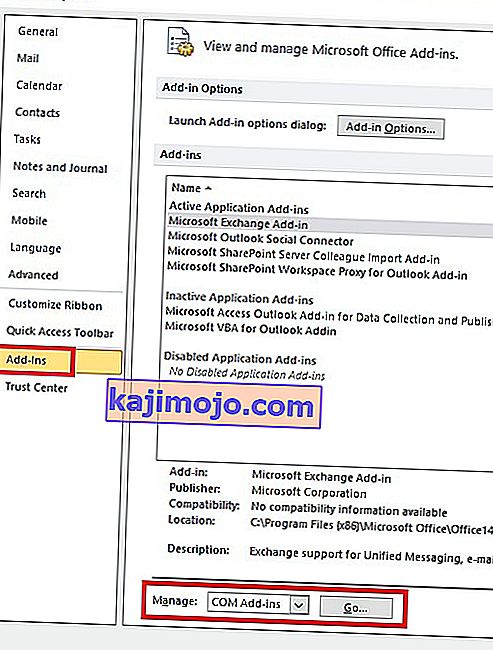
- Šiuo metu turėtumėte padaryti priedų sąrašo ekrano kopiją ir išsaugoti ją kur nors patogioje vietoje. Tai padės atkurti įprastą „Outlook“ konfigūraciją, jei išjungus priedus atsiranda kokių nors sutrikimų.
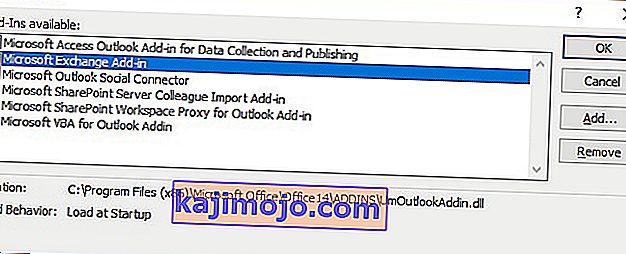
- Išjunkite kiekvieną įrašą (išvalykite pažymėtus langelius) ir paspauskite Gerai .
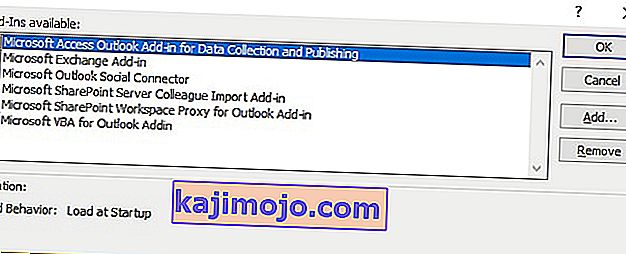 Pastaba: dar nepaspauskite „ Pašalinti“ . Pirmiausia turime patvirtinti, kad jie sukelia problemą.
Pastaba: dar nepaspauskite „ Pašalinti“ . Pirmiausia turime patvirtinti, kad jie sukelia problemą. - Uždarykite „Outlook“ ir dar kartą atidarykite atsarginę jos kopiją. Jei programa paleidžiama įprastu režimu, jūsų problema buvo išspręsta.
Pastaba: Jei jis vis tiek paleidžiamas saugiuoju režimu , eikite į Failo parinktys> Papildiniai ir vėl įjunkite priedus, kuriuos mes išjungėme atlikdami 5 veiksmą, ir pereikite prie 2 metodo .
- Grįžkite į Failas> Parinktis> Papildiniai ir sistemingai įjunkite kiekvieną priedą po vieną, kol atskleisite tą, kuris sukelia konfliktus.
- Pasirinkite jį ir paspauskite Pašalinti .
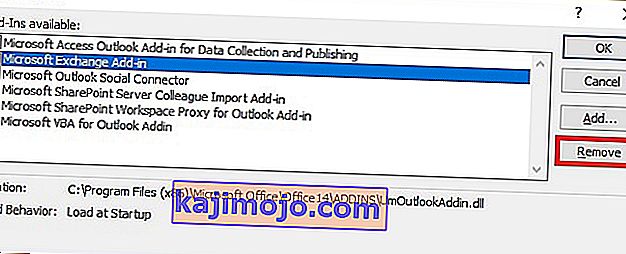
- Iš naujo paleiskite „Outlook“ ir patikrinkite, ar ji įsijungia įprastu režimu.
2 metodas: Atkurkite kompiuterį naudodami sistemos atkūrimą (visos „Outlook“ versijos)
Sistemos atkūrimas yra „Windows“ funkcija, leidžianti vartotojams grąžinti kompiuterio būseną į ankstesnį laiko tašką. Tai atitinka mūsų tikslą, jei galime grįžti į būseną, buvusią anksčiau, kai „Outlook“ pradėjo blogai veikti. Štai ką daryti:
- Laikykite „ Windows“ klavišą ir paspauskite R. Įveskite rstrui.exe ir spustelėkite Gerai .
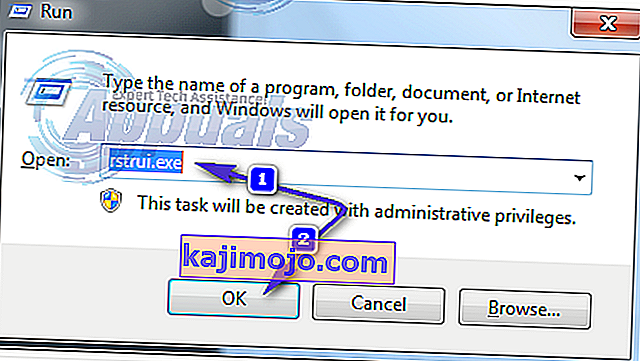
- Į System Restore langą, pasirinkite Pasirinkite kitą atkūrimo tašką ir paspauskite Next.
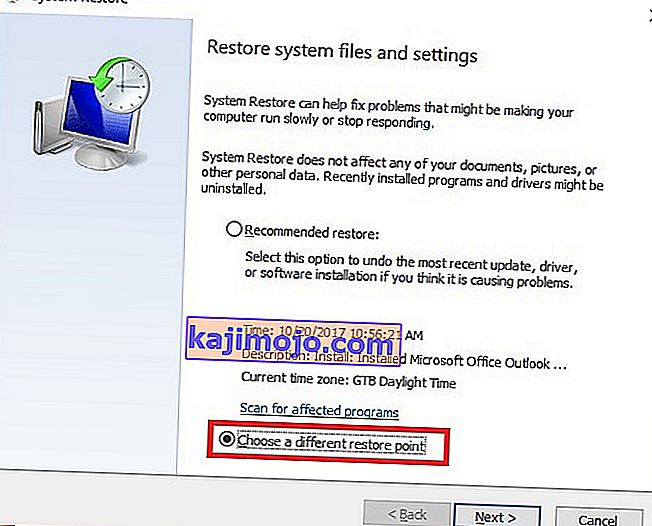
- Storis langelis šalia Rodyti daugiau atkūrimo taškų.
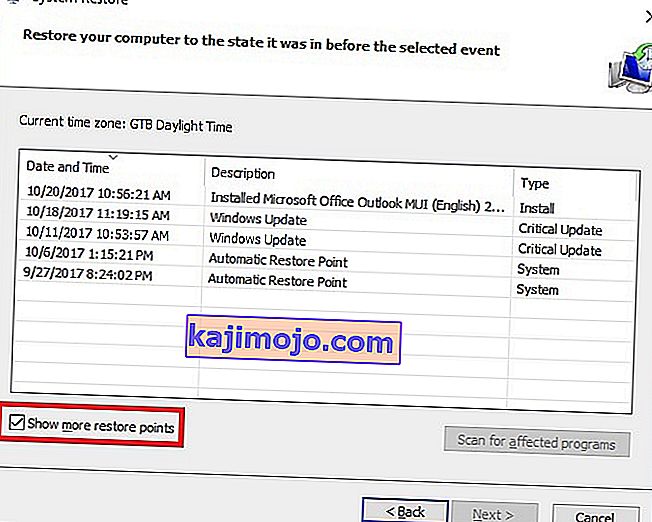
- Raskite tašką, kai „Outlook“ veikė, tada pasirinkite tą atkūrimo tašką ir tęskite ekrane pateikiamas instrukcijas, kad atkurtumėte kompiuterį anksčiau.
- Tai atlikus, sistema pradės atkurti. Baigę atkūrimą patikrinkite, ar veikia „Outlook“. jei taip nėra, pereikite prie 3 metodo .
3 metodas: atkurkite ankstesnę „Outlook“ versiją
Jei darbalaukio OS atkūrimas į ankstesnę versiją neveikė, pabandykime atkurti ankstesnę „Outlook“ versiją. Štai kaip:
- Spustelėkite Pradėti ir paieškos dialogo lange įveskite Outlook.exe . Dešiniuoju pelės mygtuku spustelėkite jį ir pasirinkite Ypatybės .
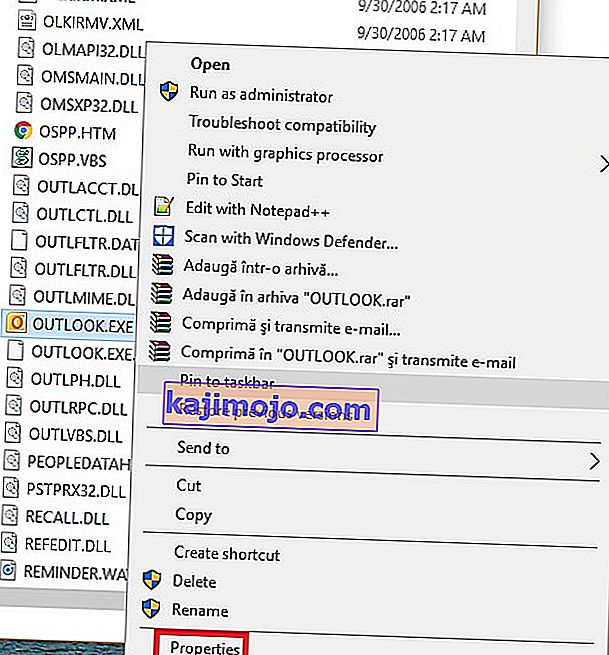
- Tada eikite į skirtuką „ Ankstesnės versijos“ ir suraskite failą „ Outlook.exe“ , kuriame nurodyta data, kada jis veikė. Spustelėkite Atidaryti, kad pamatytumėte, ar jis veikia ir atidaromas be saugiojo režimo .
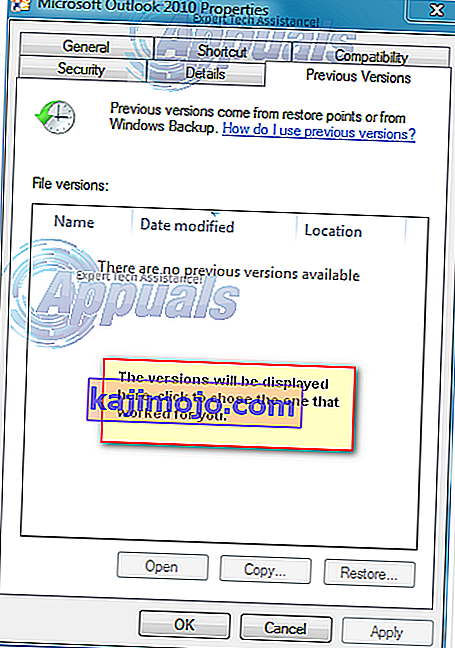 Pastaba: įsitikinkite, kad neveikianti „Outlook“, kuri anksčiau buvo atidaryta saugiuoju režimu, yra uždaryta, nes dabar vykdome vieną iš ankstesnėse versijose išsaugotų kopijų. Atlikite tą patį su visomis ten išvardytomis versijomis. Atidarykite / uždarykite, kol pamatysite tą, kuris atsidaro be saugaus režimo. Jei tai veikia, laikykite langą atidarytą.
Pastaba: įsitikinkite, kad neveikianti „Outlook“, kuri anksčiau buvo atidaryta saugiuoju režimu, yra uždaryta, nes dabar vykdome vieną iš ankstesnėse versijose išsaugotų kopijų. Atlikite tą patį su visomis ten išvardytomis versijomis. Atidarykite / uždarykite, kol pamatysite tą, kuris atsidaro be saugaus režimo. Jei tai veikia, laikykite langą atidarytą. - Darant prielaidą, kad dabar naudojate „Outlook“ versiją be saugaus režimo iš vienos iš ankstesnių versijų. Laikykite Windows Key ir paspauskite R . Įveskite taskmgr ir spustelėkite Gerai .
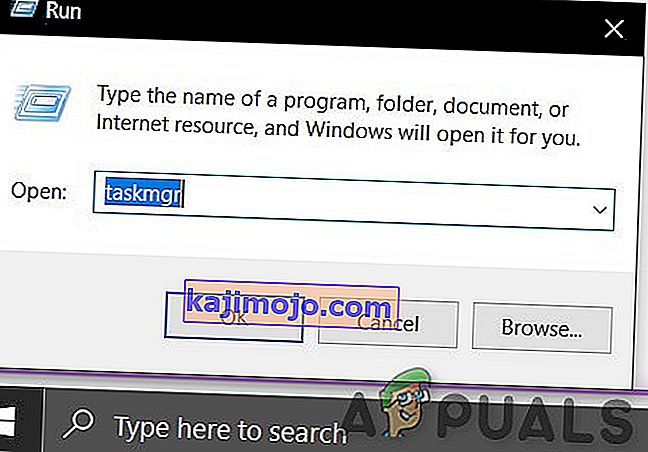
- Per Task Manager lange, eikite į proceso Tab suraskite Outlook.exe , dešiniuoju pelės mygtuku spustelėkite jį ir pasirinkti Open failo vietą.
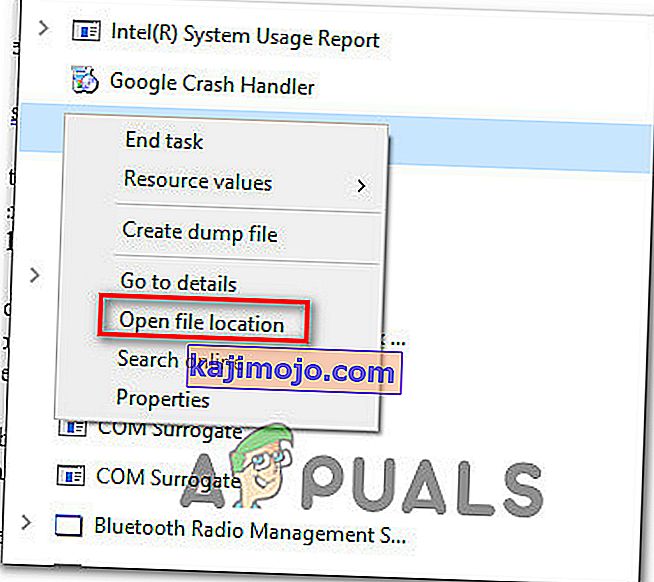
- Nukopijuokite visus failus iš kito lango, tada eikite į C: \ Program Files (x86) \ Microsoft Office \ Office. Čia įklijuokite anksčiau nukopijuotą failą.
- Pabandykite iš naujo atidaryti „Outlook“ ir pamatyti, ar ji prasideda įprastu režimu.
4 metodas: KB3114409 naujinimo pašalinimas („Outlook 2010“)
Kažkada 2015 m. „Microsoft“ išleido saugos pataisą, dėl kurios „Outlook“ veikė saugiuoju režimu ir grąžino numatytąją konfigūraciją. Vartotojo sukurtos konfigūracijos neprarandamos visiems laikams ir jos bus atnaujintos, kai „Outlook“ pavyks paleisti įprastą režimą.
Jei turite šią problemą, galite eiti dviem būdais. Kadangi „Microsoft“ išleido naujinimą, kuris išsprendžia KB3114409 sukeltą problemą , galime jį įdiegti per blogą naujinį. Kitas būdas būtų paprasčiausiai pašalinti KB3114409 .
We highly recommend you to go for installing the official Microsoft update fix. But regardless of which option you opt for, we will guide you through the whole process.
Using the official Microsoft fix
Microsoft update KB3114560 was issued specifically to fix the damage done by KB3114409. As a rule of thumb, you should always install security updates from the official website. Here’s what you need to do:
- Access this official link and click on one of the two different update versions, according to your PC specs.
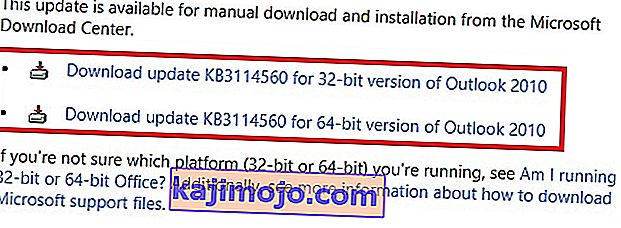
- Select the default language of your Outlook program and click on the Download button.
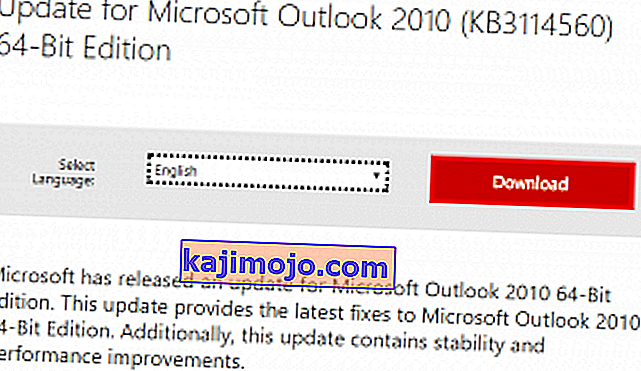
- Once the update has been downloaded, open the executable and follow through with the installation process.
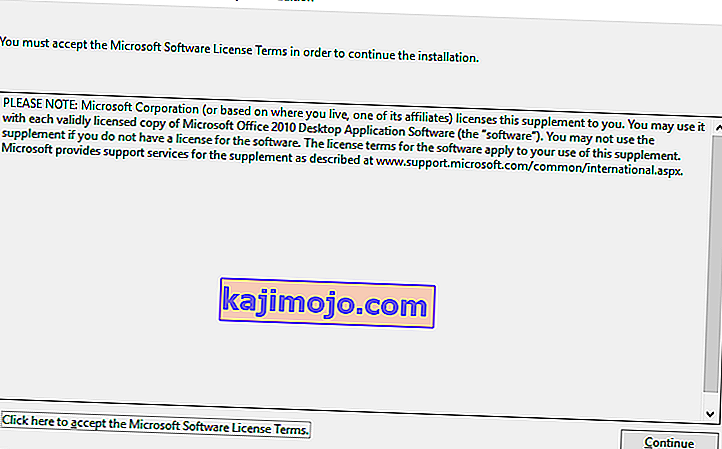
- Restart your PC, open Outlook again and see if the issue has been resolved.
Uninstalling the KB3114409 update
- Close Outlook completely.
- Open Control Panel, click on Uninstall a program.
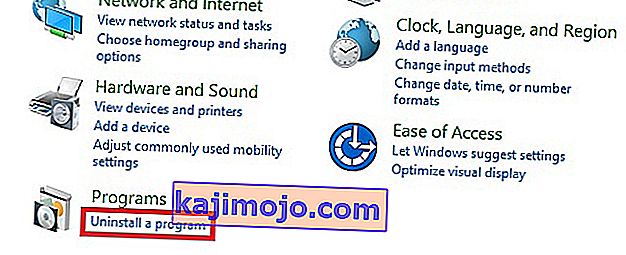
- Once you’re in the Programs and Features window, click on View installed updates.
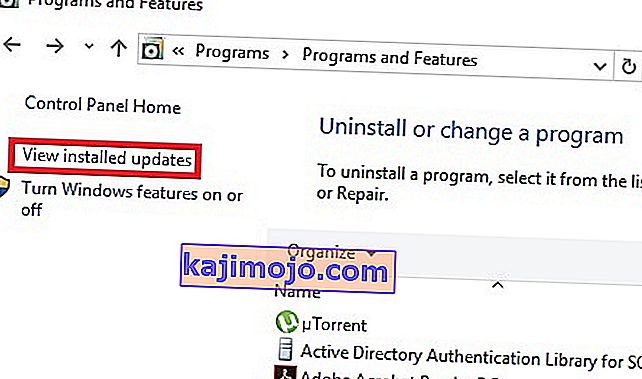
- Use the Search Installed Updates search bar in the top-right corner to search for the bad update (KB3114409 ).

- Once you manage to identify the bad update, click the Uninstall button and follow through with the confirmation prompts.
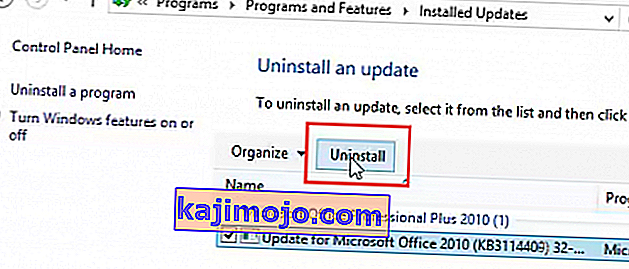
- Restart your PC, open Outlook and see if the issue repeats.
Method 5: Doing an Outlook Profile reset (All Outlook versions)
If you experience hanging at the initial Outlook splash screen (right before it initiates Safe Mode), you might need to do a profile reset. Here’s how to do it:
- Go to Control Panel > Mail and click on Show Profiles.
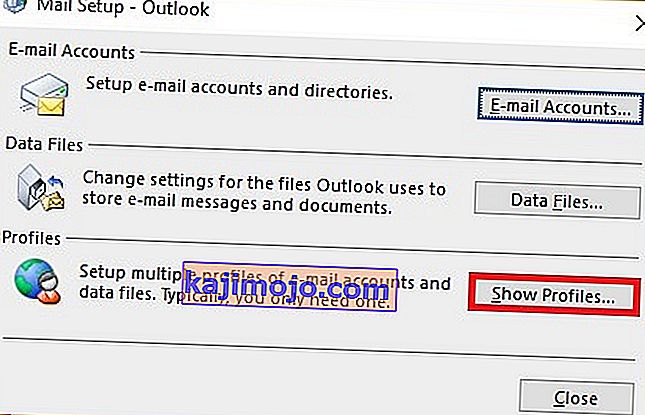
- Now, create a new profile by clicking the Add button. Insert a name and hit OK.
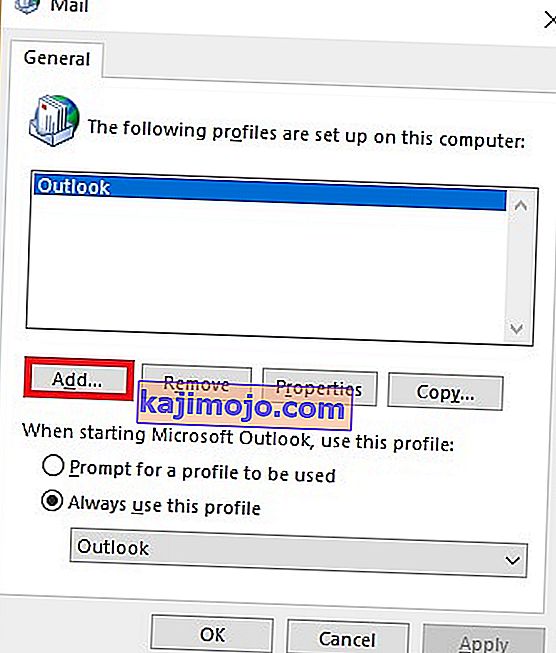
Note: Do not delete the original profile, because we don’t know if this will end up fixing the issue.
- Go through the steps of configuring your email account with Outlook. Make sure to use the same email that you have on the already created profile.
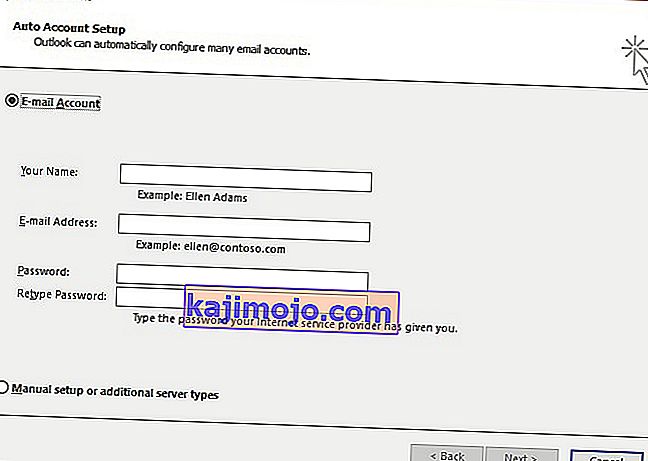
- Now return to the Mail window and make sure the profile you’ve just created is being used by default. Hit Apply to confirm your selection.
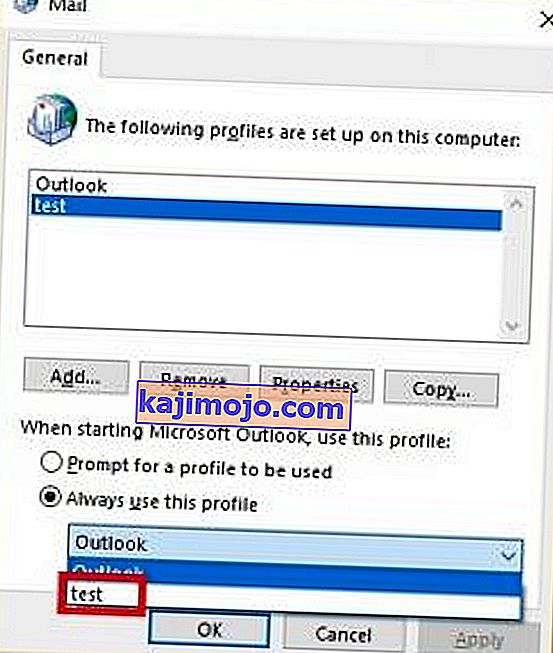
- Start Outlook again and see if it manages to start in normal mode after the profile reset.
Method 6: Checking the PST folder for corruption (All Outlook versions)
Another common cause for Outlook starting in Safe Mode is the Personal Folders File (PST). In the event that it becomes very large, or some files inside are corrupted, it might prevent the program from starting in normal mode. Luckily, you can easily check for corruption by using a Microsoft Repair tool called Scanpst.exe. Here’s what you need to do:
- Close Outlook completely and navigate to C:\ Program Files or C:\ Program Files (x86), depending on which version of Outlook you use.
- Use the search box in the top-right corner to search for SCANPST.exe.
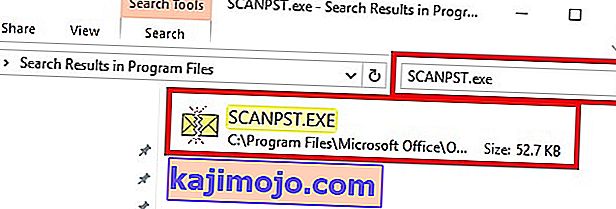 Note: If you don’t manage to find the SCANPST executable via the search bar, you need to navigate to the exact location. Here’s a list of the exact locations based on various Outlook versions:
Note: If you don’t manage to find the SCANPST executable via the search bar, you need to navigate to the exact location. Here’s a list of the exact locations based on various Outlook versions:2016: C:\Program Files (x86)\Microsoft Office\root\Office16 2013: C:\Program Files (x86)\Microsoft Office\Office15 2010: C:\Program Files (x86)\Microsoft Office\Office14 2007: C:\Program Files (x86)\Microsoft Office\Office12
- Open SCANPST.exe and set the path of the PST file you want to scan by using the Browse button. By default, the PST files are stored in Documents\Outlook Files. When you are ready, hit Start to begin the scan.
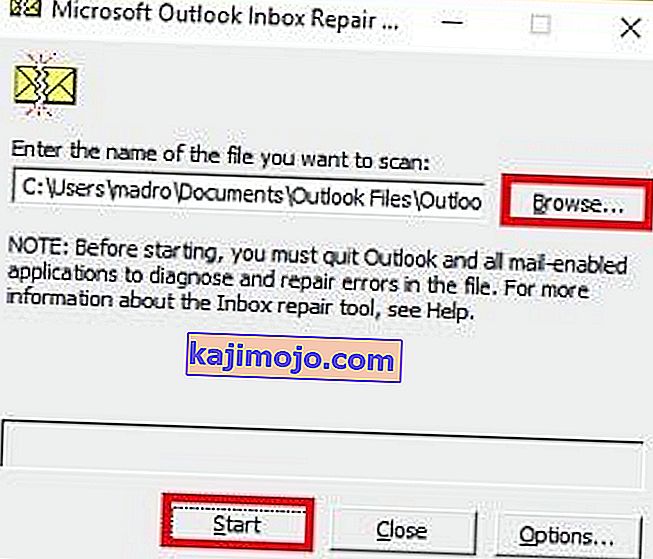
- If the scan uncovers errors or inconsistencies, click on the Repair button to fix them.
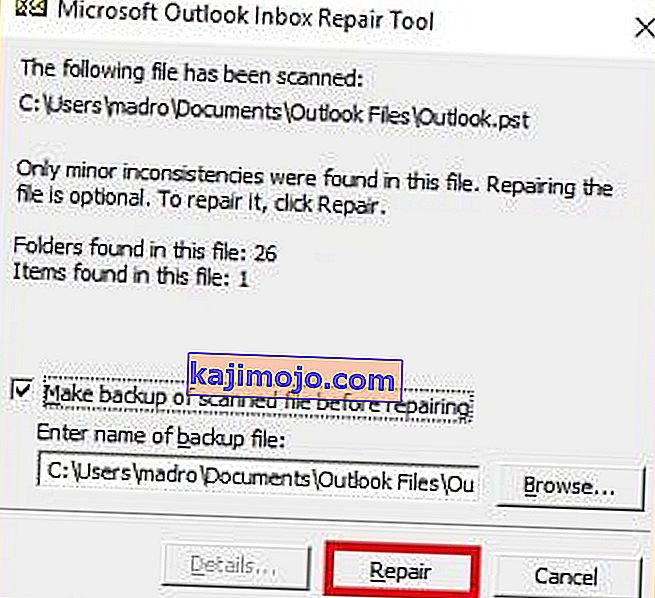
- Once the repair is done, restart Outlook with the profile that you’ve just repaired of errors and see if it starts in normal mode.
Method 7: Running the /resetnavpane command (All Outlook versions)
The navigation pane is that left portion of Outlook where you can oversee your folder list and access various icons to move between calendar, people, tasks, and mails. Sometimes, it can become glitched and prevent Outlook from starting in normal mode. Luckily, there is a command that removes any customizations to the navigation pane and gets rid of any glitch. Even better, this is done outside Outlook with ease. Here’s how:
- Close Outlook completely.
- Go to Start and access the Run application.
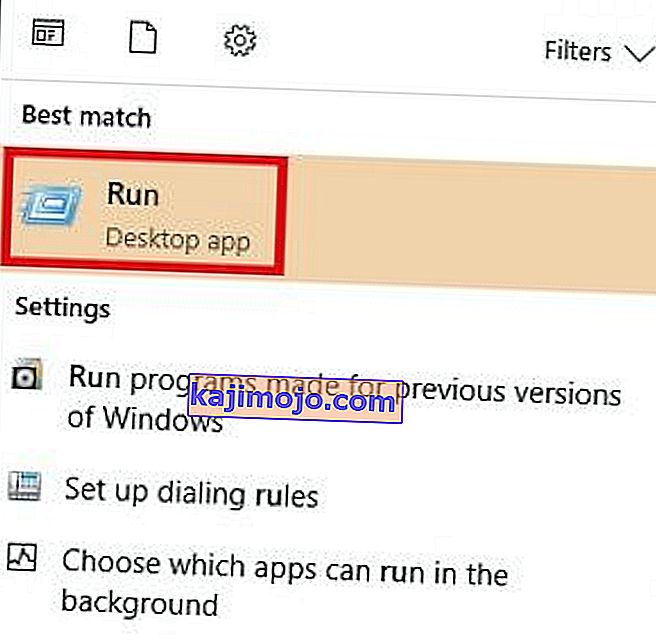
- Now, type Outlook.exe /resetnavpaneand hit OK.
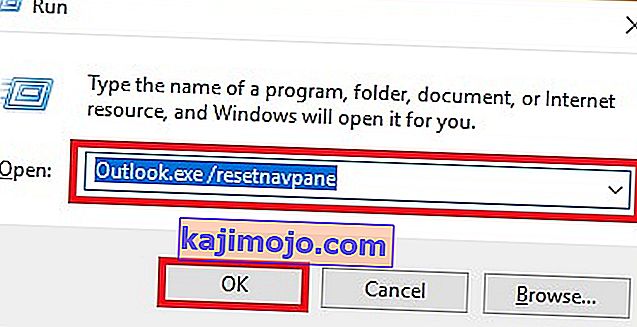 Note: Keep in mind that any customization to the navigation pane will be lost after you click on OK.
Note: Keep in mind that any customization to the navigation pane will be lost after you click on OK. - Shortly after, Outlook should automatically open in normal mode.
Method 8: Disabling compatibility mode
A lot of users have reported that they managed to start Outlook in normal mode after finding out it was running in compatibility mode. Compatibility mode is designed to help a program run as if it was running on an older operating system. As it turns out, turning off compatibility mode might just fix your Outlook Safe Mode problem. Here’s how:
- Close Outlook and navigate to the Outlook.exe on your computer. The exact path of it will differ, depending on your Outlook version. Here’s a list of the exact paths depending on your Outlook version:
2016 - C:\Program Files (x86)\Microsoft Office\root\Office16 2013 - C:\Program Files (x86)\Microsoft Office\Office 15 2010 - C:\Program Files (x86)\Microsoft Office\Office 14 2007: C:\Program Files (x86)\Microsoft Office\Office12

- Right-click on Outlook.exe and click on Properties.
- Now click on the Compatibility tab and make sure the box directly under Compatibility Mode is unchecked. Hit Apply to confirm your selection.
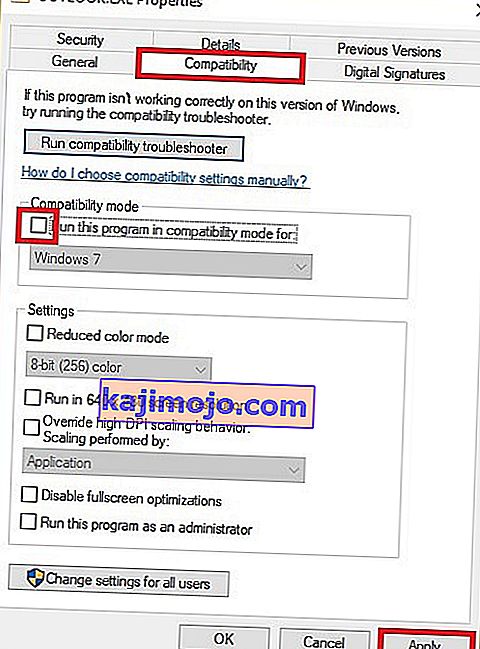
- Finally, open Outlook from the same Outlook executable and see if it manages to start in normal mode.
Method 9: Disabling hardware acceleration (All Outlook versions)
As it turns out, Outlook tries to use hardware acceleration whenever it can to make things as seamless as possible. If you’re Outlook forces itself into Safe Mode, it could very well be an issue with hardware acceleration. We can check to see if that’s the case by making some minor tweaks inside regedit. Here’s how:
- Go to Start and open the Run application.
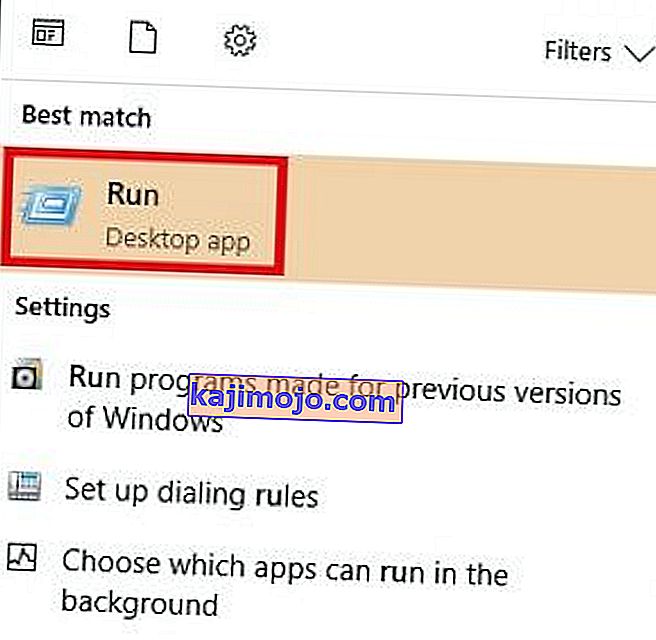
- Search for regedit and click OK to open the Registry Editor.
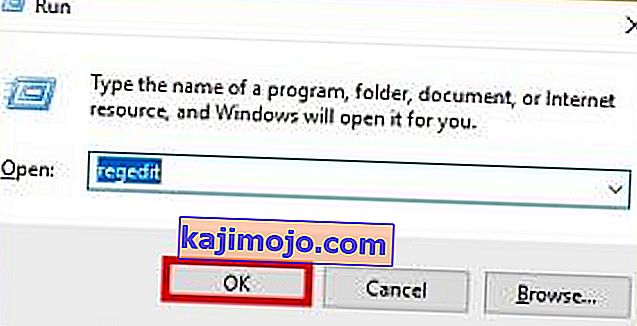
- Navigate your way to the following location
HKEY_CURRENT_USER\ Software\ Microsoft\ Office.
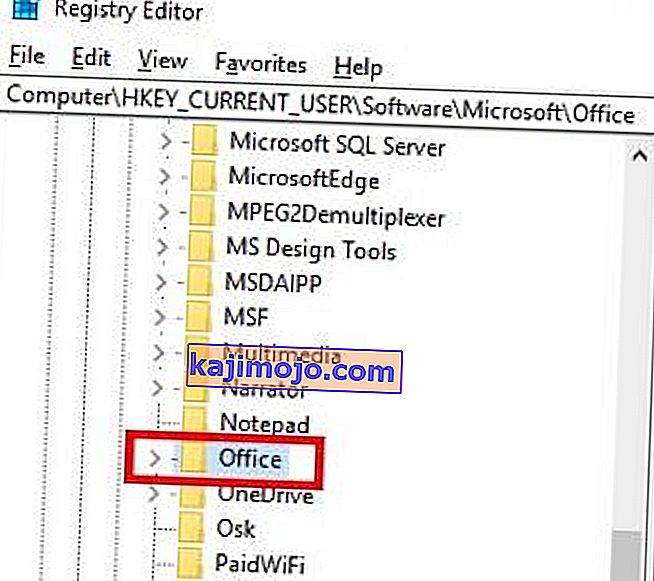
- Now, depending on which Outlook version you have, you might encounter different folders. You should either see a folder named 14.0, 16.0 or 8.0. Either way, click on the folder and double-click on the Common folder.
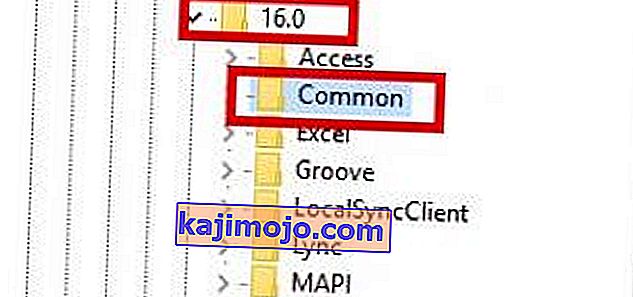
- Right-click anywhere in the Common folder, select New and click on Key and name it Graphics.
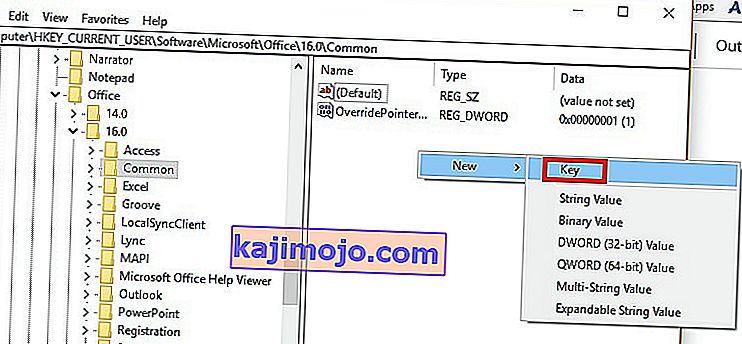
- Select the newly created Graphics folder and right-click on the right panel. From there, create a New Dword (32-bit) Value and name it DisableHardwareAcceleration.
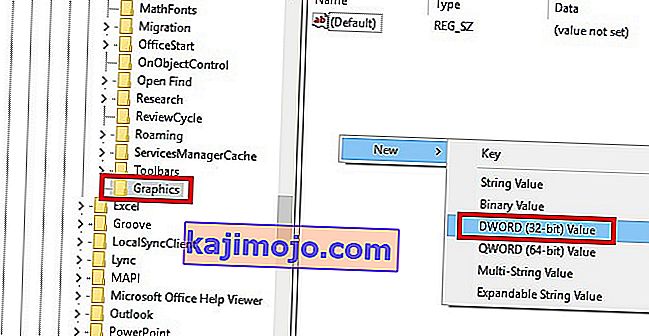
- Now double-click on DisableHardwareAcceleration and set the Value Data to 1 and hit Ok.
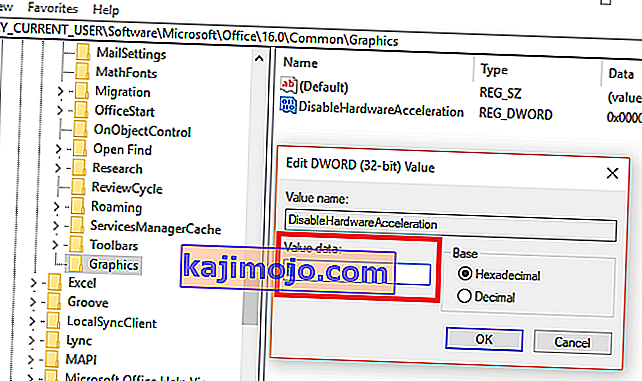
- Close regedit and open Outlook again to see if it starts in normal mode.
Method 10: Resetting the Safe Mode Registry Key (Outlook 2010)
If you have unsuccessfully followed all the methods above, there’s one more thing you can try. A final solution would be to try and prevent Safe Mode from kicking in by tweaking the registry key. But keep in mind that after you’ll follow the steps below, you won’t be able to use Safe mode in the future. At least not until you remove the key that we will create. Here’s what you need to do:
- Go to Start and open the Run application.

- Search for regedit and click OK.

- Navigate your way through HKEY_CURRENT_USER\ Software\ Microsoft\ Office.

- Now, depending on which Outlook version you have, you might encounter different folders. You should either see a folder named 14.0, 16.0 or 8.0. Either way, click on the folder navigate further to Outlook \ Security.
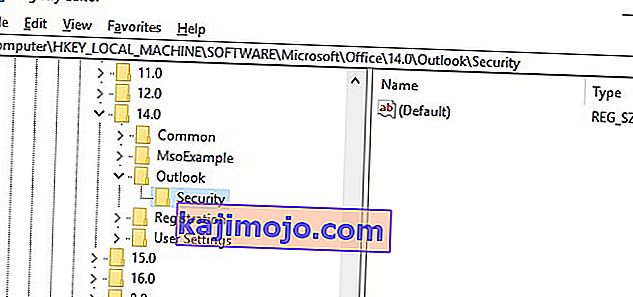 Note: If the Security folder is missing, Right-click > New > Key and type Security.
Note: If the Security folder is missing, Right-click > New > Key and type Security. - Right-click on the Security key and choose New > then DWORD (32-bit) Value.
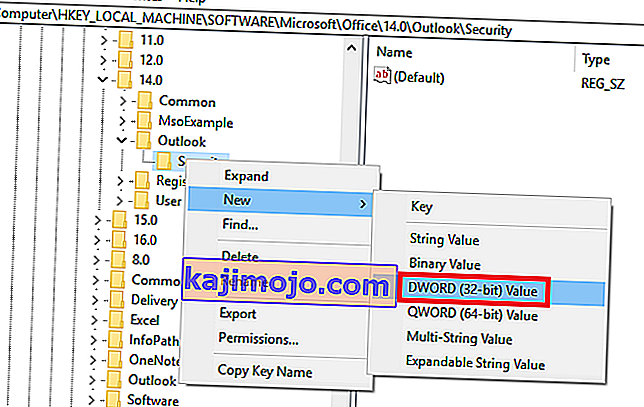
- Name it DisableSafeMode and press Enter to confirm.
- Right-click on DisableSafeMode and click on Modify.
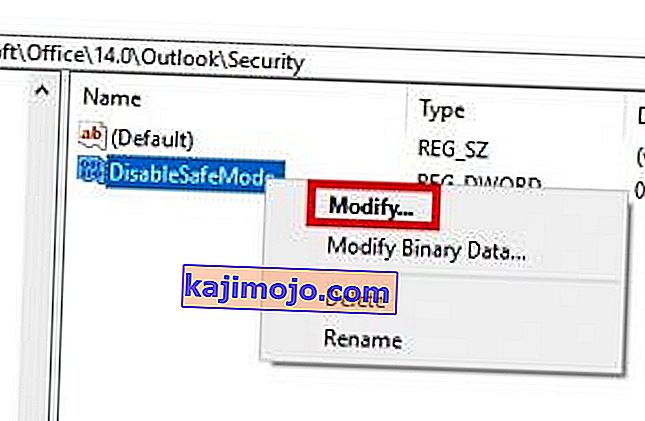
- Įveskite reikšmę 1 į lauką Vertės duomenys ir spustelėkite Gerai .

- Uždarykite registro rengyklę ir iš naujo paleiskite kompiuterį.
- Atidarykite „Outlook“ ir pažiūrėkite, ar ji veikia įprastu režimu.






 Pastaba: dar nepaspauskite „ Pašalinti“ . Pirmiausia turime patvirtinti, kad jie sukelia problemą.
Pastaba: dar nepaspauskite „ Pašalinti“ . Pirmiausia turime patvirtinti, kad jie sukelia problemą.




 Pastaba: įsitikinkite, kad neveikianti „Outlook“, kuri anksčiau buvo atidaryta saugiuoju režimu, yra uždaryta, nes dabar vykdome vieną iš ankstesnėse versijose išsaugotų kopijų. Atlikite tą patį su visomis ten išvardytomis versijomis. Atidarykite / uždarykite, kol pamatysite tą, kuris atsidaro be saugaus režimo. Jei tai veikia, laikykite langą atidarytą.
Pastaba: įsitikinkite, kad neveikianti „Outlook“, kuri anksčiau buvo atidaryta saugiuoju režimu, yra uždaryta, nes dabar vykdome vieną iš ankstesnėse versijose išsaugotų kopijų. Atlikite tą patį su visomis ten išvardytomis versijomis. Atidarykite / uždarykite, kol pamatysite tą, kuris atsidaro be saugaus režimo. Jei tai veikia, laikykite langą atidarytą.












 Note: If you don’t manage to find the SCANPST executable via the search bar, you need to navigate to the exact location. Here’s a list of the exact locations based on various Outlook versions:
Note: If you don’t manage to find the SCANPST executable via the search bar, you need to navigate to the exact location. Here’s a list of the exact locations based on various Outlook versions:


 Note: Keep in mind that any customization to the navigation pane will be lost after you click on OK.
Note: Keep in mind that any customization to the navigation pane will be lost after you click on OK.








 Note: If the Security folder is missing, Right-click > New > Key and type Security.
Note: If the Security folder is missing, Right-click > New > Key and type Security.

